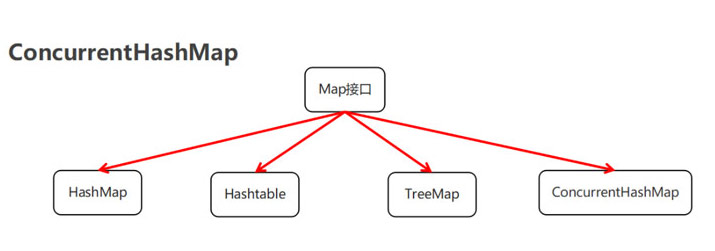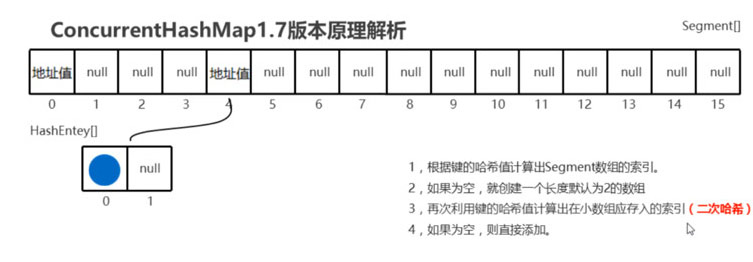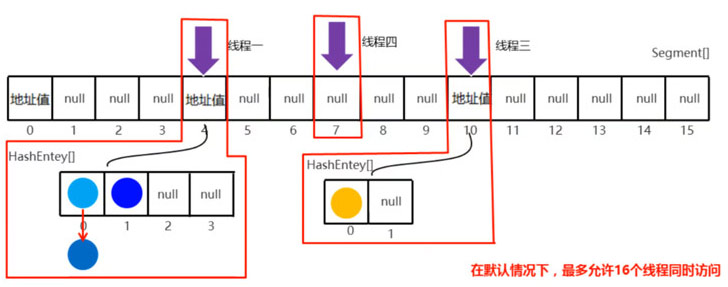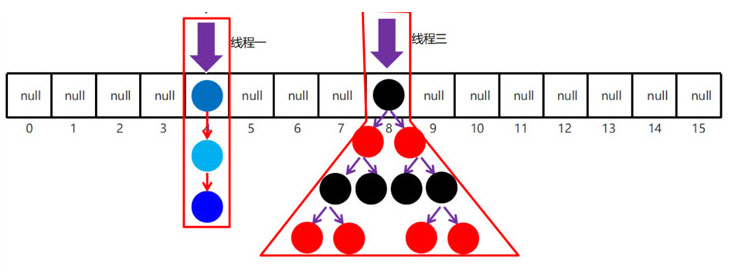更新时间:2022-08-24 来源:黑马程序员 浏览量:
一、糟糕的面试
面试官:小王,你说说HashMap的是线程安全的吗?
小王:HashMap不安全,在多线程下,会出现线程安全问题。他兄弟HashTable
线程是安全的,但是出于性能考虑,我们往往会选择ConcurrentHashMap。
面试官:HashMap线程不安全的原因是什么?
小王:这个...暂时忘记了
面试官:为什么HashTable线程安全,为什么性能低?
小王:这个...
面试官:ConcurrentHashMap是怎么实现线程安全的?性能为什么较高?
小王:...
面试官:回答的很不错,回去等通知吧。

二、hashMap
2.1 暴露问题
大家都知道,HashMap在多线程下会存在线程安全问题,如下:
```java
public class Demo2 {
public static void main(String[] args) {
//shift+ctrl+alt+u
HashMap<String, String> map = new HashMap<>();
Thread t1 = new Thread(new Runnable() {
@Override
public void run() {
for (int i = 0; i <= 10; i++) {
map.put(i+"",i+"");
}
}
});
Thread t2 = new Thread(new Runnable() {
@Override
public void run() {
for (int i = 11; i <= 20; i++) {
map.put(i+"",i+"");
}
}
});
t1.start();
t2.start();
//确保两个子线程执行完毕之后,主线程再来打印hashmap
try {
Thread.sleep(1000);
} catch (InterruptedException e) {
e.printStackTrace();
}
//遍历hashMap
for (int i = 1; i <= 20; i++) {
System.out.println(map.get(i + ""));
}
}
}
```控制台:
```
null
2
null
null
null
6
7
8
9
10
null
null
13
null
null
null
17
18
19
20
```
以上例子证明了,HashMap确实存在线程安全问题。
2.2 源码追踪
翻阅源码(1.8)如下:
```java
final V putVal(int hash, K key, V value, boolean onlyIfAbsent,
boolean evict) {
Node<K,V>[] tab; Node<K,V> p; int n, i;
if ((tab = table) == null || (n = tab.length) == 0)
n = (tab = resize()).length;
//此处线程不安全
if ((p = tab[i = (n - 1) & hash]) == null)
tab[i] = newNode(hash, key, value, null);
else {
Node<K,V> e; K k;
if (p.hash == hash &&
((k = p.key) == key || (key != null && key.equals(k))))
e = p;
else if (p instanceof TreeNode)
e = ((TreeNode<K,V>)p).putTreeVal(this, tab, hash, key, value);
else {
for (int binCount = 0; ; ++binCount) {
if ((e = p.next) == null) {
p.next = newNode(hash, key, value, null);
if (binCount >= TREEIFY_THRESHOLD - 1) // -1 for 1st
treeifyBin(tab, hash);
break;
}
if (e.hash == hash &&
((k = e.key) == key || (key != null && key.equals(k))))
break;
p = e;
}
}
if (e != null) { // existing mapping for key
V oldValue = e.value;
if (!onlyIfAbsent || oldValue == null)
e.value = value;
afterNodeAccess(e);
return oldValue;
}
}
++modCount;
//此处线程不安全。
if (++size > threshold)
resize();
afterNodeInsertion(evict);
return null;
}
```(1)代码一
```java if ((p = tab[i = (n - 1) & hash]) == null) tab[i] = newNode(hash, key, value, null); ```
是否Hash冲突,没冲突就直接赋值给数组当前索引。
线程A判断通过,进入方法,切换B线程,判断通过,进入方法,切换A线程,赋值成功,切换B线程赋值成功,B线程的值覆盖了A线程的值,发生了数据覆盖,用户感受到是数据丢失。
(2) 代码二
```java if (++size > threshold) resize(); ```
当元素个数size大于扩容阈值,则扩容,这里会有两个问题。
- 成员的size变量没有保证原子性,因此多线程下size自增是存在原子性问题。即添加了两个元素,但是size只增加了1。
- 两个线程如果都通过上面阈值的判断,就会发生扩容两次的情况,这也是一种安全问题。
三、HashTable
3.1 线程安全演示
我们可以使用HashTable来解决上面的安全问题。
看下面的代码:
```java
public class Demo2 {
public static void main(String[] args) {
Hashtable<String, String> map = new Hashtable<>();
Thread t1 = new Thread(new Runnable() {
@Override
public void run() {
for (int i = 0; i <= 10; i++) {
map.put(i+"",i+"");//{i,i}
}
}
});
//20,20 21,21 ... 39,39
Thread t2 = new Thread(new Runnable() {
@Override
public void run() {
for (int i = 11; i <= 20; i++) {
map.put(i+"",i+"");//{i,i}
}
}
});
t1.start();
t2.start();
//确保两个子线程执行完毕之后,主线程再来打印hashmap
try {
Thread.sleep(1000);
} catch (InterruptedException e) {
e.printStackTrace();
}
for (int i = 0; i <= 20; i++) {
System.out.println(map.get(i + ""));
}
}
}
```控制台:
```java
0
1
2
3
4
5
6
7
8
9
10
11
12
13
14
15
16
17
18
19
20
```
以上代码,说明了Hashtable的确是线程安全的。
3.2 翻看源码
Hashtable源码:
```java
public synchronized V put(K key, V value) {
// Make sure the value is not null
if (value == null) {
throw new NullPointerException();
}
// Makes sure the key is not already in the hashtable.
Entry<?,?> tab[] = table;
int hash = key.hashCode();
int index = (hash & 0x7FFFFFFF) % tab.length;
@SuppressWarnings("unchecked")
Entry<K,V> entry = (Entry<K,V>)tab[index];
for(; entry != null ; entry = entry.next) {
if ((entry.hash == hash) && entry.key.equals(key)) {
V old = entry.value;
entry.value = value;
return old;
}
}
addEntry(hash, key, value, index);
return null;
}
public synchronized V get(Object key) {
Entry<?,?> tab[] = table;
int hash = key.hashCode();
int index = (hash & 0x7FFFFFFF) % tab.length;
for (Entry<?,?> e = tab[index] ; e != null ; e = e.next) {
if ((e.hash == hash) && e.key.equals(key)) {
return (V)e.value;
}
}
return null;
}
public synchronized int size() {
return count;
}
```通过阅读源码可以发现,Hashtable每个操作数据的方法,都是使用了重量级锁synchronized。线程A在操作数据的时候,线程B只能阻塞。保证了整个Hash表只能线程串行化执行,从而解决了多线程产生的安全问题。
因为Hashtable是对整个哈希表进行加锁,加锁粒度过大,发生线程阻塞的概率非常大,虽然synchronized有自己的锁优化机制,但是也很快就会升级成重量级锁。而当synchronized成为了重量级锁,就会请求底层系统锁,跳出jvm级别,频繁涉及用户态和内核态的切换,性能开销比较大。
所以在今天已经不推荐使用HashTable了。
四、ConcurrentHashMap
4.1 线程安全演示
以上两个章节我们发现,在Map集合中HashMap是最常用的集合对象。但是多线程操作HashMap会有线程安全问题,解决方式就是使用HashTable,但是HashTable会全表加锁性能牺牲很大。
JDK1.5以后所提供了ConcurrentHashMap,使用它既能解决线程安全问题,性能又比HashTable高很多,所以这是目前主流的折中方案。
代码如下:
```java
public class Demo3 {
public static void main(String[] args) {
ConcurrentHashMap<String, String> map = new ConcurrentHashMap<>();
Thread t1 = new Thread(new Runnable() {
@Override
public void run() {
for (int i = 0; i <= 10; i++) {
map.put(i + "", i + "");//{i,i}
}
}
});
//20,20 21,21 ... 39,39
Thread t2 = new Thread(new Runnable() {
@Override
public void run() {
for (int i = 11; i <= 20; i++) {
map.put(i + "", i + "");//{i,i}
}
}
});
t1.start();
t2.start();
//确保两个子线程执行完毕之后,主线程再来打印hashmap
try {
Thread.sleep(1000);
} catch (InterruptedException e) {
e.printStackTrace();
}
for (int i = 0; i <= 20; i++) {
System.out.println(map.get(i + ""));
}
}
}
```控制台:
```java
0
1
2
3
4
5
6
7
8
9
10
11
12
13
14
15
16
17
18
19
20
```
线程安全得到保证。
总结 :
1 ,HashMap是线程不安全的。多线程环境下会有数据安全问题
2 ,Hashtable是线程安全的,但是会将整张表锁起来,效率低下
3,ConcurrentHashMap也是线程安全的,效率较高。 在JDK7和JDK8中,底层原理不一样。
4.2 jdk7原理解析
1.ConcurrentHashMap集合底层是一个默认长度为16,加载因子为0.75的大数组 Segment数组。大数组通常是创建之后长度就固定的,而扩容是指小数组扩容。
2.默认情况下还会创建一个长度为2的小数组,把地址赋值给0索引处,其他索引此时的元素仍为null。
`(Segment` 继承 `ReentrantLock` 锁,用于存放数组 `HashEntry[]`。)
如下图

3.调用put方法时,此时会根据key的哈希值来计算出在大数组中存储的索引位置。
如果这个索引此时为null,则按照0素引的模板小数组来创建小数组。创建完毕后会**二次哈希**计算出key在小数组中存储的位置,然后把键值对对象存储小数组的该索引位。
如下图,先根据key的哈希算出来在大数组的4索引,创建小数组挂在4索引。接着继续使用key的hash算出存在小数组的0素引。

4.调用put方法时,此时会根据key的哈希值来计算出在大数组中存储的索引位置。
如果该位置不为null,就会根据记录的地址值找到小数组。二次哈希计算出小数组的索引位置。
如果需要扩容就把小数组扩容2倍。
如果不需要扩容,则会判断小数组该索引是否有元素
如果没有元素,就直接存
如果有元素,就调用equals方法比较key是否相同
比较发现没有重复,就会在小数组上挂链表。
如下图

线程一来访问索引4,此时就会对索引4的Segment进行加锁。其他线程访问索引4就会阻塞,访问其他索引就可以访问,这种技术叫分段锁,将数据拆成一段一段的进行加锁。
在当前例子中,我们没有指定大数组的长度,因此长度默认是 16。在理想情况下,最多可以支持16个线程同时操作不同的segment对象,达到了并发的目的。但是如果多个线程同时操作同一个segment,就会阻塞,串行化执行。
关键字:分段锁、二次哈希、Segment数组不能扩容、HashEntry数组可以扩容
总结:
ConcurrentHashMap1.7使用Segment+HashEntry数组实现的。本质上是一个 Segment 数组,Segment 继承 ReentrantLock ,同时具备了加锁和释放锁的功能。每个Segment都线程安全,全局也就安全了。把Hashtable的锁全表,变成了锁一段段的数据,粒度细提高性能。
补充:ConcurrentHashMap1.8则完全不同,放弃了Segment。数据结构使用synchronized+CAS+红黑树。锁的粒度也从段锁缩小为结点锁,粒度更细,同时数组支持扩容,并发能力更高。使用synchronized其实也是因为1.6jdk对synchronized的优化有关。
4.3 jdk8 原理解析
在1.8中,ConcurrentHashMap可以说发生翻天覆地的变化,底层数据结构不再采用segment数组,也不再采用分段锁。而是采用 数组+链表+红黑树来实现,锁也从分段锁提升成了节点锁,粒度更细。使用CAS+synchronized来保证线程安全。
底层结构:数组+链表+红黑树
CAS + synchronized同步代码块 保证线程安全

初始化数组源码如下:
```java
//假设多线程来扩容,concurrentHashMap为了线程安全,只能让一个线程成功初始化数组,其他线程均失败。
private final Node<K,V>[] initTable() {
Node<K,V>[] tab; int sc;
//所有线程进入循环,去抢着初始化数组
while ((tab = table) == null || tab.length == 0) {
if ((sc = sizeCtl) < 0)
Thread.yield(); //让线程让出cpu,以至于把cpu更多的可能让给初始化操作的线程
//CAS操作,保证一个线程进入下面的逻辑,其他线程最终只能执行 Thread.yield();
else if (U.compareAndSwapInt(this, SIZECTL, sc, -1)) {
try {
if ((tab = table) == null || tab.length == 0) {
int n = (sc > 0) ? sc : DEFAULT_CAPACITY;
@SuppressWarnings("unchecked")
//这个就是初始化数组,默认长度n为16
Node<K,V>[] nt = (Node<K,V>[])new Node<?,?>[n];
table = tab = nt;
sc = n - (n >>> 2);
}
} finally {
sizeCtl = sc;
}
break;
}
}
return tab;
}
```通过源码发现,这里使用了 自旋+CAS+线程让出cpu。
其中 自旋+Cas:初始化操作必须且只会由一个线程执行一次,不会初始化多个数组。
线程让出cpu:提高性能,让初始化操作更快执行
put操作源码如下:
```java
final V putVal(K key, V value, boolean onlyIfAbsent) {
if (key == null || value == null) throw new NullPointerException();
int hash = spread(key.hashCode());
int binCount = 0;
for (Node<K,V>[] tab = table;;) {
Node<K,V> f; int n, i, fh;
//如果数组是null,说明第一次put,那就初始化数组
if (tab == null || (n = tab.length) == 0)
tab = initTable();
//根据key找到索引,如果此索引为null,则使用CAS将node直接赋给当前索引
else if ((f = tabAt(tab, i = (n - 1) & hash)) == null) {
if (casTabAt(tab, i, null,
new Node<K,V>(hash, key, value, null)))
break; // no lock when adding to empty bin
}
//如果当前索引位置的元素的hash==MOVED说明此时正在发生数组扩容的数据迁移操作,
//当前线程帮助完成数据迁移
else if ((fh = f.hash) == MOVED)
tab = helpTransfer(tab, f);
//当前索引既不是null,也没有在数据迁移。此时索引位置存储的要么链表要么红黑树
else {
V oldVal = null;
//对头结点进行加结点锁,保证同索引下的结点线程串行化执行
synchronized (f) {
if (tabAt(tab, i) == f) {
if (fh >= 0) {
binCount = 1;
for (Node<K,V> e = f;; ++binCount) {
K ek;
if (e.hash == hash &&
((ek = e.key) == key ||
(ek != null && key.equals(ek)))) {
oldVal = e.val;
if (!onlyIfAbsent)
e.val = value;
break;
}
Node<K,V> pred = e;
if ((e = e.next) == null) {
pred.next = new Node<K,V>(hash, key,
value, null);
break;
}
}
}
else if (f instanceof TreeBin) {
Node<K,V> p;
binCount = 2;
if ((p = ((TreeBin<K,V>)f).putTreeVal(hash, key,
value)) != null) {
oldVal = p.val;
if (!onlyIfAbsent)
p.val = value;
}
}
}
}
if (binCount != 0) {
if (binCount >= TREEIFY_THRESHOLD)
treeifyBin(tab, i);
if (oldVal != null)
return oldVal;
break;
}
}
}
addCount(1L, binCount);
return null;
}
```通过源码发现:
put操作如果没有发生hash冲突,则CAS直接赋值到索引
如果发生了hash冲突,判断此时是否正在扩容数据迁移,是就加入帮忙数据迁移
如果此时是链表或者红黑树,就加节点锁,保证当前索引操作的线程串行化执行。
扩容源码如下:
```java
private final void transfer(Node<K,V>[] tab, Node<K,V>[] nextTab) {
int n = tab.length, stride;
//计算步长,算法的目的是,cpu核数越多,步长越小。
//步长最少为16,最多为数组的长度
if ((stride = (NCPU > 1) ? (n >>> 3) / NCPU : n) < MIN_TRANSFER_STRIDE)
stride = MIN_TRANSFER_STRIDE; // subdivide range
if (nextTab == null) { // initiating
try {
@SuppressWarnings("unchecked")
Node<K,V>[] nt = (Node<K,V>[])new Node<?,?>[n << 1];
nextTab = nt;
} catch (Throwable ex) { // try to cope with OOME
sizeCtl = Integer.MAX_VALUE;
return;
}
nextTable = nextTab;
transferIndex = n;
}
int nextn = nextTab.length;
ForwardingNode<K,V> fwd = new ForwardingNode<K,V>(nextTab);
boolean advance = true;
boolean finishing = false; // to ensure sweep before committing nextTab
for (int i = 0, bound = 0;;) {
Node<K,V> f; int fh;
while (advance) {
int nextIndex, nextBound;
if (--i >= bound || finishing)
advance = false;
else if ((nextIndex = transferIndex) <= 0) {
i = -1;
advance = false;
}
else if (U.compareAndSwapInt
(this, TRANSFERINDEX, nextIndex,
nextBound = (nextIndex > stride ?
nextIndex - stride : 0))) {
bound = nextBound;
i = nextIndex - 1;
advance = false;
}
}
if (i < 0 || i >= n || i + n >= nextn) {
int sc;
if (finishing) {
nextTable = null;
table = nextTab;
sizeCtl = (n << 1) - (n >>> 1);
return;
}
if (U.compareAndSwapInt(this, SIZECTL, sc = sizeCtl, sc - 1)) {
if ((sc - 2) != resizeStamp(n) << RESIZE_STAMP_SHIFT)
return;
finishing = advance = true;
i = n; // recheck before commit
}
}
else if ((f = tabAt(tab, i)) == null)
advance = casTabAt(tab, i, null, fwd);
else if ((fh = f.hash) == MOVED)
advance = true; // already processed
else {
synchronized (f) {
if (tabAt(tab, i) == f) {
Node<K,V> ln, hn;
if (fh >= 0) {
int runBit = fh & n;
Node<K,V> lastRun = f;
for (Node<K,V> p = f.next; p != null; p = p.next) {
int b = p.hash & n;
if (b != runBit) {
runBit = b;
lastRun = p;
}
}
if (runBit == 0) {
ln = lastRun;
hn = null;
}
else {
hn = lastRun;
ln = null;
}
for (Node<K,V> p = f; p != lastRun; p = p.next) {
int ph = p.hash; K pk = p.key; V pv = p.val;
if ((ph & n) == 0)
ln = new Node<K,V>(ph, pk, pv, ln);
else
hn = new Node<K,V>(ph, pk, pv, hn);
}
setTabAt(nextTab, i, ln);
setTabAt(nextTab, i + n, hn);
setTabAt(tab, i, fwd);
advance = true;
}
else if (f instanceof TreeBin) {
TreeBin<K,V> t = (TreeBin<K,V>)f;
TreeNode<K,V> lo = null, loTail = null;
TreeNode<K,V> hi = null, hiTail = null;
int lc = 0, hc = 0;
for (Node<K,V> e = t.first; e != null; e = e.next) {
int h = e.hash;
TreeNode<K,V> p = new TreeNode<K,V>
(h, e.key, e.val, null, null);
if ((h & n) == 0) {
if ((p.prev = loTail) == null)
lo = p;
else
loTail.next = p;
loTail = p;
++lc;
}
else {
if ((p.prev = hiTail) == null)
hi = p;
else
hiTail.next = p;
hiTail = p;
++hc;
}
}
ln = (lc <= UNTREEIFY_THRESHOLD) ? untreeify(lo) :
(hc != 0) ? new TreeBin<K,V>(lo) : t;
hn = (hc <= UNTREEIFY_THRESHOLD) ? untreeify(hi) :
(lc != 0) ? new TreeBin<K,V>(hi) : t;
setTabAt(nextTab, i, ln);
setTabAt(nextTab, i + n, hn);
setTabAt(tab, i, fwd);
advance = true;
}
}
}
}
}
}
```通过源码发现:
ConcurrentHashMap采用的是多线程扩容,来提高扩容的效率。总体思想是,cpu核数越多线程越多,每个线程分得数据迁移任务量越小。
步长:单个线程负责迁移的桶数量。
下面做一个模拟扩容的流程:
假设现在数组长度有512,cpu核数2,步长32。
线程一:负责迁移索引(512-步长-1,512-1),即数组[479] - 数组[511]
线程二:负责迁移索引 数组[446] 数组[478]
如果线程一和线程二都执行完毕,两个线程就会通过CAS去抢下一个任务
如果线程二抢到了,数组[413] 数组[445]
线程一失败了,自旋继续CAS抢,抢到了
线程一 数组[381] 数组[412]
4.4 对比区别
(1)1.7用的是segment+hashentry数组实现的分段锁。只要线程没同时访问同一个分段数组,就可以并行访问默认长度16,segment数组不可以扩容(大数组),hashentry数组可以扩容。
(2)1.8用的是CAS+synchronized+voletile 实现的,底层是数组+链表+红黑树。对比1.7 锁的粒度更细,锁到了节点级别。
(3)1.8为什么synchronized替换segment?ReentrantLock:park unpark 用户态 - 内核态 性能开销比较大。synchronized:1.6之后优化了,偏向锁 轻量级锁 。此时加锁粒度非常小,比1.7小。转成重量级锁概率极小。
五、总结
通过上面的学习得知,hashmap在多线程情况下初始化数组和扩容的时候均会出现线程安全问题。我们可以通过HashTable来解决,HashTable是对整个hash表加锁,相当于线程串行化操作hash表,在解决问题的同时也会导致性能极低。最终我们可以使用ConcurrentHashMap将锁的粒度控制到最小,将性能影响控制到最低,同时扩容的时候ConcurrentHashMap还支持多线程扩容。可以说ConcurrentHashMap是多线程操作hashmap场景的不二之选,比如SpringCache框架中就使用了ConcurrentHashMap来作为本地缓存。